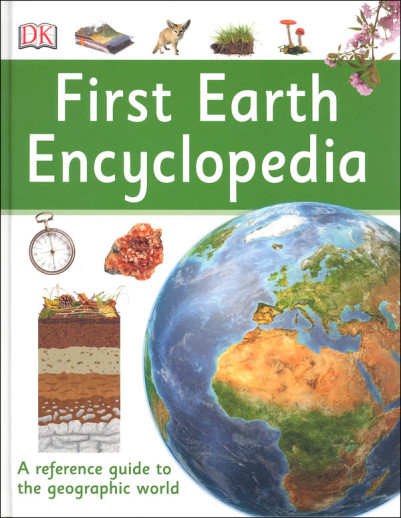We use cookies to make your experience better. To comply with the new e-Privacy directive, we need to ask for your consent to set the cookies. Learn more.
First Earth Encyclopedia
How big is the Sahara? Which products are in greatest demand around the world? You just might need a good reference book to come up with the answers to these and many other questions. First Earth Encyclopedia by DK has the same visual appeal as other DK products and is packed full of information and interesting facts for children from a secular perspective. Every page is laid out in a scrapbooking style with photographs and accompanying text. An extension question is printed at the bottom of each even-numbered page and the answer can be found at the bottom of the odd numbered pages (upside down). "Turn and Learn" icons tell you where to look for additional information within the book, and "Hands on' activities show you how you can try some things for yourself. You will find these scattered through the color-coded pages of the book. Children will find information on the world's physical geography, our living world (ecosystems), human geography, and maps. A reference section at the back of the book includes a map of the world, photos of unique locations on earth, a view of the earth at night, a quiz, glossary and more. I'm always a fan of DK books even for non-reading, younger children. This hardcover, 136-page book is no exception. ~ Donna
Learn all about planet Earth--the geography of the land and oceans and the geography of its people.
Have you ever wondered how mountains are formed or what causes earthquakes and tsunamis? What makes an area of land a country, what's the most populated region of the world, and who speaks what language where? First Earth Encyclopedia answers these questions and much more! This human and physical geography encyclopedia for kids is the perfect introduction to planet Earth. Part of the First Reference series, this engaging book covers human geography, physical geography, geology, and ecology. Topics include where and how people live, how to use maps, the weather, world environments, and changes in the environment. Physical geography and geology explain how the Earth was formed and shaped. Human geography helps children gain a sense of place, and understand how the world works and where they fit into it. An added section on maps and mapping gives a complete look at how we look at the Earth.


Need this for Elemental Science.
part of Elemental Science's Earth Science and Astronomy for the Grammar Stage curriculum
Recommended by Earth Science & Astronomy for the Grammar Stage book
I wanted to have supplemental visuals for teaching geology. These are excellent and informative books.